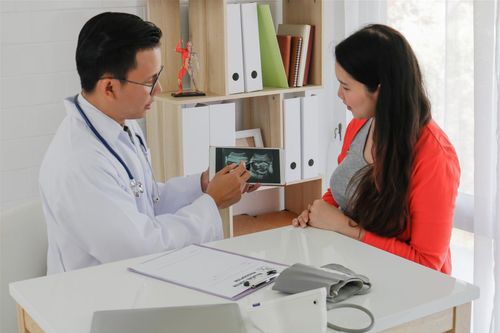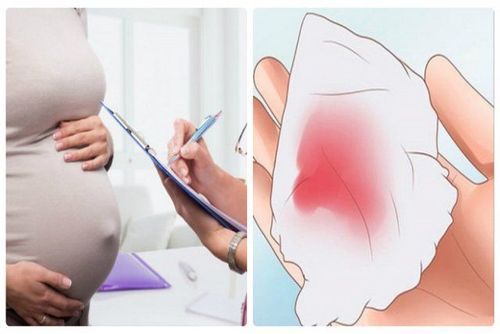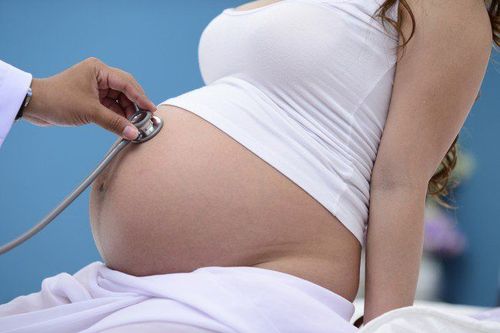This is an automatically translated article.
Uterine rupture is one of the dangerous obstetric complications for both mother and fetus. Uterine rupture often occurs during pregnancy and labor. Both of these uterine ruptures are dangerous especially for uterine rupture in labor.
1. What is uterine rupture in labor?
Uterine rupture during labor is divided into two groups: spontaneous uterine rupture occurring without surgical intervention and uterine rupture due to intervention by obstetric procedures such as intrauterine rotation, endotracheal support. breech delivery, forceps delivery, suction, abdominal thrusting during the period of pushing...
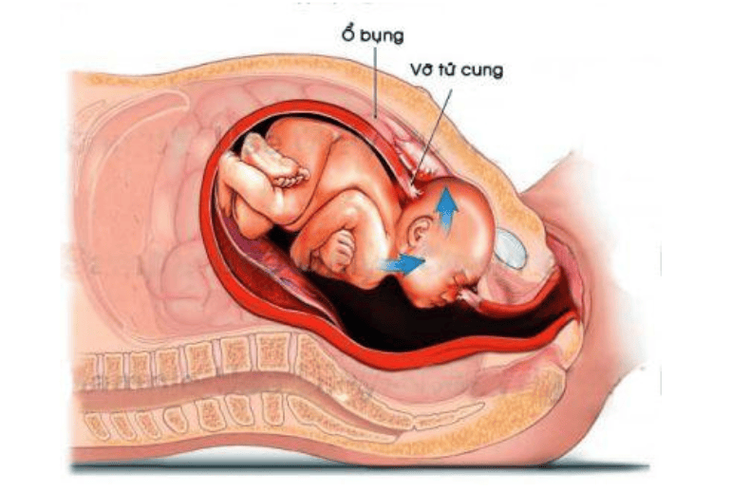
Vỡ tử cung trong chuyển dạ là một tai biến trong sản khoa
2. Causes of uterine rupture in labor
There are many causes of uterine rupture during labor. It can mainly be divided into 3 types of causes: maternal causes, fetal causes, and interventional causes.
2.1 Causes from the mother's side Difficulty giving birth due to absolute narrow pelvis, narrow middle and lower waist, distorted pelvis... or because there is a tumor in the prostate such as a myoma in the isthmus, an ovarian cyst, some other tumors in the pelvic area... The mother has an old cesarean section scar in the uterus The mother has given birth many times, has a history of multiple pregnancies, so the uterine muscles are thinner, thinner and more fragile than the mother has many abortions, abortions 2.2 Causes from the fetus side The baby is grossly enlarged, weighing more than 4kg, causing disproportion between the fetus and the mother's pelvis Partially enlarged fetus such as hydrocephalus Due to fetal position and abnormal position: The head is not well bowed, the chin position, the forehead position, the fontanel position, the transverse position Multiple pregnancy leads to placental entanglement and deformity 2.3 Causes of intervention Causes pregnant mothers are not performed the correct procedures only specified, unqualified or not technically correct. Using tocolytic drugs incorrectly in terms of indications, doses, not carefully monitored.
3. Pathological Anatomy
3.1 Complete Uterine Rupture This form accounts for 80% of uterine rupture cases. The entire thickness of the uterine wall is torn (mucosa, muscle to peritoneum). The tear site is usually on the left and anterior aspect of the lower uterine segment, the tear can extend from the cervix to the uterine body. In fetal complete uterine rupture, the amniotic fluid is pushed into the mother's abdomen, so the mother is susceptible to peritonitis.
3.2 Incomplete Uterine Rupture This form is also known as subperitoneal rupture of the uterus. Only the mucosal layer and muscle layer were torn, the lower peritoneum was detached but not torn. Blood does not flow into the mother's abdomen, but into the broad ligament, forming a hematoma in the ligament and pelvis. In case of uterine rupture, the fetus is incomplete and the placenta is still in the uterus, so the fetus can be alive.
3.3 Uterine rupture in a person with an old surgical scar Usually caused by a ruptured or partially cracked uterine scar, in this case the tear margin is not jagged and sometimes there is little bleeding.
3.4 Complicated Rupture Complicated Uterine Injury includes complete uterine rupture with extensive lesions that may extend into the vagina, tearing of the sacrum, bladder, or rupture of the uterine artery. Due to complex injuries, pregnant women are often in severe shock, so the management is difficult and the postoperative period is heavy.
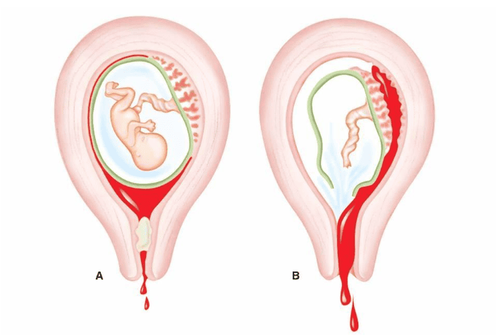
Thai phụ cần được phẫu thuật, cấp cứu để xử trí kịp thời vỡ tử cung trong chuyển dạ
4. Symptoms of uterine rupture in labor
Symptoms of uterine rupture in labor will experience symptoms that signal threatened uterine rupture during labor and symptoms that lead to actual uterine rupture.
In particular, the state of threatened uterine rupture in labor only occurs on the uterus without the old surgical scar with the main symptoms being that the pregnant woman feels a lot of abdominal pain, the uterine contractions are rapid, strong, and fast. With subclinical signs, pregnant women will have the following signs:
Bandl ring up high, as high as the navel and above the navel means that the uterus is about to rupture, the uterus is shaped like a gourd Frommel's sign is two ligaments round stretched, stretched like a string Fetal heart can be normal, irregular or heart failure Vaginal examination shows that the head is not high enough, signs of asymmetry of the pelvis, body due to causes such as narrow pelvis, Abnormal position When there are symptoms of uterine rupture in labor, pregnant women need to be treated immediately by setting up an intravenous line with 9% NaCl or Ringer Lactat, catheterization and performing an emergency cesarean section to ensure the safety of both mother and fetus.
In the state of symptoms of uterine rupture in labor, such as the mother with signs of threatened rupture, sudden sharp pain, then subsided but the general condition gradually worsened. The mother has a state of shock, blue skin, pale mucous, fast, light pulse, difficult to catch, gradually cold hands and feet, low blood pressure. There are signs of vaginal bleeding, the urine may be red.
With subclinical signs, pregnant women with uterine rupture during labor will have signs:
General symptoms are shock Abdomen deformed, bulging When palpating, there is a reaction to the abdominal wall, pain in many places rupture, fetal palpation, no fundus palpable if the fetus is pushed out of the uterine cavity Low percussion or full abdominal percussion Fetal heart failure, not even auscultation of the fetal heart Vaginal examination may not Seeing the fetal position, bright red blood according to the examination gloves In case of uterine rupture after normal delivery, the delivery will help see bright red blood from the uterine cavity, stun, check the uterus to detect breaks in the lower uterine segment, wounds cervical laceration up to the lower uterine segment. The surgical scar is not intact, thin or has broken open.
5. Management of uterine rupture in labor
All types of uterine rupture require emergency surgery, both resuscitation and surgery to ensure safety for both mother and fetus. During this process, resuscitate against shock by replenishing lost blood and administering electrolytes. At the same time, the surgery is based on the specific situation of the pregnant woman and finally, the restoration of the uterus is done with the young pregnant woman who still wants to give birth, and has an uncomplicated tear.
For pregnant women of many years of age, having given birth many times with enough children, having complicated infection and uterine rupture, it is recommended to treat with hysterectomy to ensure safety and complications later.
6. How to prevent uterine rupture in labor?
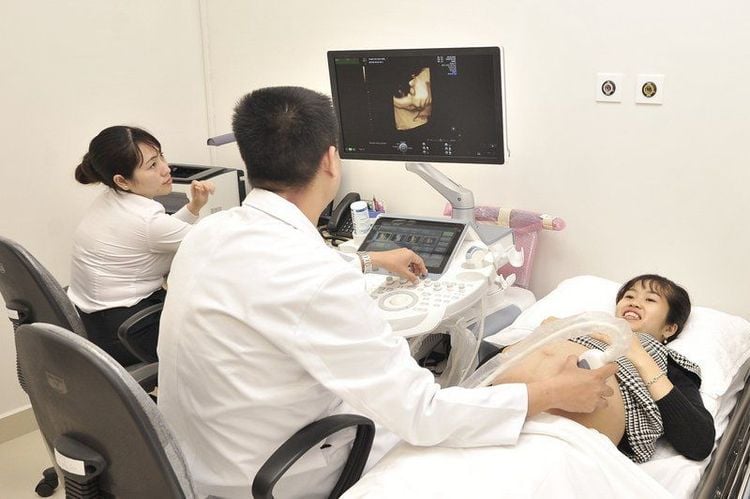
Cần khám thai thường xuyên đúng chỉ định trong thai kỳ để phát hiện sớm các vấn đề có thể gây vỡ tử cung
Pregnant women during pregnancy need to know preventive measures to lower the rate of uterine rupture in labor by:
Regular antenatal check-ups are required during pregnancy to detect early causes of uterine rupture. As mentioned above, pregnant women with uterine scars must be admitted to the hospital before labor for monitoring and timely intervention, limiting the risk of uterine rupture occurring During labor, early examination to detect the cause of difficult delivery. use the labor chart to monitor, detect early signs of labor delay, threatened uterine rupture for timely handling Use the right medication, dosage and must be carefully and closely monitored When performing Procedures such as rotation, abortion, suction... need to be properly indicated and qualified. After the procedure, the integrity of the birth canal must be checked. It is forbidden to push the abdomen during the period of pregnancy. Stomach is a very dangerous obstetric complication. If not detected and treated promptly, it can cause death for mother and fetus. Therefore, when there are signs of an ectopic pregnancy, the pregnant mother should identify the fetal mass that can rupture at any time and need to be closely monitored by the doctor.
Currently, with the program "Maternity package" at Vinmec International General Hospital, mothers will be monitored, ultrasound, and tested regularly throughout pregnancy until childbirth and after birth, helping The birth becomes more comfortable and gentle, grasp and promptly handle health during the period.
Please dial HOTLINE for more information or register for an appointment HERE. Download MyVinmec app to make appointments faster and to manage your bookings easily.





